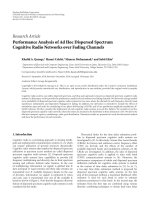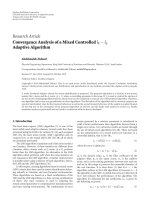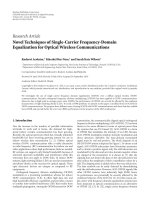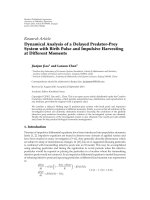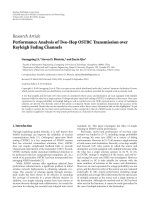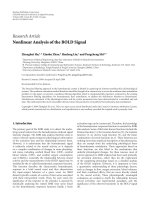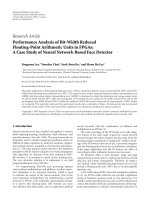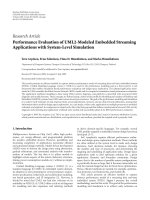Báo cáo hóa học: " Research Article Performance Analysis of SSC Diversity Receivers over Correlated Ricean Fading Satellite Channels" doc
Bạn đang xem bản rút gọn của tài liệu. Xem và tải ngay bản đầy đủ của tài liệu tại đây (718.51 KB, 9 trang )
Hindawi Publishing Corporation
EURASIP Journal on Wireless Communications and Networking
Volume 2007, Article ID 25361, 9 pages
doi:10.1155/2007/25361
Research Article
Performance Analysis of SSC Diversity Receivers over
Correlated Ricean Fading Satellite Channels
Petros S. Bithas and P. Takis Mathiopoulos
Institute for Space Applications and Remote Sensing, National Observatory of Athens, Metaxa and Vas. Pavlou Street,
15236 Athens, Greece
Received 3 October 2006; Revised 23 February 2007; Accepted 6 April 2007
Recommended by Ray E. Sheriff
This paper studies the performance of switch and stay combining (SSC) diversity receivers operating over correlated Ricean fading
satellite channels. Using an infinite series representation for the bivariate Ricean probability density function (PDF), the PDF of
the SSC output signal-to-noise ratio (SNR) is derived. Capitalizing on this PDF, analytical expressions for the corresponding cu-
mulative distribution function (CDF), the moments of the output SNR, the moments generating function (MGF), and the average
channel capacity (CC) are der ived. Furthermore, by considering several families of modulated signals, analytical expressions for
the average symbol error probability (ASEP) for the diversity receivers under consideration are obtained. The theoretical analy-
sis is accompanied by representative performance evaluation results, including average output SNR (ASNR), amount of fading
(AoF), outage probability (P
out
), average bit error probability (ABEP), and average CC, which have been obtained by numerical
techniques. The validity of some of these performance evaluation results has been verified by comparing them with previously
known results obtained for uncorrelated Ricean fading channels.
Copyright © 2007 P. S. Bithas and P. T. Mathiopoulos. This is an open access article distributed under the Creative Commons
Attribution License, which permits unrestricted use, distribution, and reproduction in any medium, provided the original work is
properly cited.
1. INTRODUCTION
The mobile terrestrial and satellite communication channel
is particularly dynamic due to multipath fading propaga-
tion, having a strong negative impact on the average bit er-
ror probability (ABEP) of any modulation scheme [1]. Di-
versity is a powerful communication receiver technique used
to compensate for fading channel impairments. The most
important and widely used diversity reception methods em-
ployed in digital communication receivers are maximal-ratio
combining (MRC), equal-gain combining (EGC), selection
combining (SC), and switch and stay combining (SSC) [2].
For SSC diversity considered in this paper, the receiver se-
lects a particular br anch until its signal-to-noise ratio (SNR)
drops below a predetermined threshold. When this happens,
the combiner switches to another branch and stays there re-
gardless of whether the SNR of that branch is above or be-
low the predetermined threshold. Hence, among the above-
mentioned diversity schemes, SSC is the least complex and
can be used in conjunction with coherent, noncoherent, and
differentially coherent modulation schemes. It is also well
known that in many real life communication scenarios the
combined signals are correlated [2, 3]. A typical example for
such signal correlation exists in relatively small-size mobile
terminals where typically the distance between the diversity
antennas is short. Due to this correlation between the signals
received at the diversity branches there is a degradation in the
achievable diversity gain.
The Ricean fading distribution is often used to model
propagation paths consisting of one strong direct line-of-
sight (LoS) signal and many randomly reflected and usually
weaker signals. Such fading environments are typically en-
countered in microcellular and mobile satellite radio links
[2]. In particular for mobile satellite communications the
Ricean distribution is used to a ccurately model the mo-
bile satellite channel for single- [4] and clear-state [5]chan-
nel conditions. Furthermore, in [6] it was depicted that the
Ricean K-factor characterizes the land mobile satellite chan-
nel during unshadowed p eriods.
The technical literature concerning diversity receivers op-
erating over correlated fading channels is quite rich, for ex-
ample, see [7–13]. In [7] expressions for the outage probabil-
ity (P
out
) and the ABEP of dual SC with correlated Rayleigh
fading were derived either in closed form or in terms of
2 EURASIP Journal on Wireless Communications and Networking
single integrals. In [8] the cumulative distribution functions
(CDF) of SC, in correlated Rayleigh, Ricean, and Nakagami-
m fading channels were derived in terms of single-fold in-
tegrals and infinite series expressions. In [9] the ABEP of
dual-branch EGC and MRC receivers operating over corre-
lated Weibull fading channels was obtained. In [10] the per-
formance of MRC in nonidentical correlated Weibull fad-
ing channels with arbitrary parameters was evaluated. In
[11] an analysis for the Shannon channel capacity (CC) of
dual-branch SC diversity receivers operating over correlated
Weibull f ading was presented. In [12], infinite series expres-
sions for the capacity of dual-branch MRC, EGC, SC, and
SSC diversity receivers over Nakagami-m fading channels
have been derived.
Past work concerning the performance of SSC operat-
ing over correlated fading channels can be found in [14–
17]. One of the first attempts to investigate the performance
of SSC diversity receivers operating over independent and
correlated identical distributed Ricean fading channels was
made in [14]. However, in this reference only noncoher-
ent frequency shift keying (NCFSK) modulation was con-
sidered and its ABEP has been derived in an integral rep-
resentation form. In [15] the performance of SSC diversity
receivers was investigated for different fading channels, in-
cluding Rayleigh, Nakagami-m and Ricean, and under dif-
ferent channel conditions but dealt mainly with uncorre-
lated fading. For correlated fading in this reference only the
Nakagami-m distribution was studied. In [16] the moments
generating function (MGF) of SSC was presented in terms of
a finite integral representation for the correlated Nakagami-
m fading channel. In [17] expressions for the average output
SNR (ASNR), amount of fading (AoF) and P
out
for the cor-
related log-normal fading channels have been derived.
All in all, the problem of theoretically analyzing the per-
formance of SSC over correlated Ricean fading channels has
not yet been thoroughly addressed in the open technical lit-
erature. The main difficulty in analyzing the perfor mance of
diversity receivers in correlated Ricean fading channels is the
complicated form of the received signal bivariate probability
density function (PDF), see [14, Equation (17)], and the ab-
sence of an alternative and more convenient expression for
the multivariate distribution. An efficient solution to these
difficulties is to employ an infinite series representation for
the bivariate PDF, such as those that were proposed in [18]
or [19]. Such a n appr oach was used in [20] to analyze the per-
formance of MRC, EGC, and SC in the presence of correlated
Ricean fading. Similarly here the most important statistical
metrics a nd the capacity of SSC diversity receivers operat-
ing over correlated Ricean fading channels will be studied. In
particular, we derive the PDF, CDF, MGF, moments and the
average CC of such receivers operating over correlated Ricean
fading channels. Furthermore, analytical expressions for the
average symbol error probability (ASEP) of several modula-
tion schemes will be obtained. Capitalizing on these expres-
sions, a detailed performance analysis for the P
out
,ASNR,
AoF, and ASEP/ABEP will be presented.
The remainder of this paper is organized as follows. Af-
ter this introduction, in Section 2 the system model is intro-
duced. In Section 3, the SSC received signal statistics are pre-
sented, while in Section 4 the capacity is obtained. Section 5
contains the derivation of the most important performance
metrics of the SSC output SNR. In Section 6,variousnumer-
ical evaluation results are presented and discussed, while the
conclusions of the paper can be found in Section 7.
2. SYSTEM MODEL
By considering a dual-branch SSC diversity receiver operat-
ing over a correlated Ricean fading channel, the baseband re-
ceived signal at the th (
= 1 and 2) input branch can be
mathematically expressed as
ζ
= sh
+ n
. (1)
In the above equation, s is the transmitted complex sym-
bol, h
is the Ricean fading channel complex envelope with
magnitude R
=|h
|,andn
is the additive white Gaus-
sian noise (AWGN) having single-sided power spectral den-
sity of N
0
. The usual assumption for ideal fading phase esti-
mation is made, and hence, only the distributed fading enve-
lope and the AWGN affect the received signal. Moreover, the
AWGN is assumed to be uncorrelated between the two diver-
sity branches. The instantaneous SNR per symbol at the th
input branch is γ
= R
2
E
s
/(2N
0
), where E
s
= E|s|
2
is the
transmitted average symbol energy, where
E· denoting ex-
pectation and
|·|absolute value. The corresponding average
SNR per symbol at both input branches is
γ = ΩE
s
/N
0
,where
Ω
= ER
2
. The PDF of the SNR of the Ricean distribution
is given by [2, Equation (2.16)]
f
γ
(γ) =
1+K
γ
exp
−
K −
(1 + K)
γ
γ
×
I
0
2
K(K +1)
γ
γ
1/2
,
(2)
where K is the Ricean K-factor defined as the power ratio
of the specular signal to the scattered signals and I
0
(·) is the
zeroth-order modified Bessel function of the first kind [21,
Equation (8.406)]. The CDF of γ is given by [14,Equation
(8)]
F
γ
(γ) = Q
1
√
2K,
2(1 + K)
γ
γ
,(3)
where Q
1
(·) is the first-order Marcum-Q function [2,Equa-
tion (4.33)].
The joint PDF of γ
1
and γ
2
, presented in [14,Equation
(17)], can be expressed in terms of infinite series by follow-
ing a similar procedure as for deriving [18, Equation (9)].
Hence, substituting I
0
(·) with its infinite series representa-
tion [21, Equation (8.445)], expanding the term [γ
1
+ γ
2
+
2
√
γ
1
γ
2
cos(θ)]
i
using the multinomial identity [22,Equa-
tion (24.1.2)], using [21, Equation (3.389/1)] and after s ome
P. S. Bithas and P. T. Mathiopoulos 3
mathematical manipulations the joint PDF of γ
1
, γ
2
can be
expressed as
f
γ
1
,γ
2
γ
1
, γ
2
=
∞
i,h=0
v
1
+v
2
+v
3
=i
A exp
− β
1
γ
1
+ γ
2
×
Bγ
β
2
−1
1
γ
β
3
−1
2
+ Cγ
−1
γ
β
2
−1/2
1
γ
β
3
−1/2
2
(4)
with
A
=
2
v
3
+2h−1
(1 + K)
1+β
4
ρ
2h
K
i
exp
− 2K/(1 + ρ)
√
πγ
1+β
4
1 − ρ
2
1+2h
v
1
!v
2
!v
3
!i!(1 + ρ)
2i
,
B
=
1+(−1)
v
3
Γ
h +
1+v
3
/2
Γ
h +1+v
3
/2
Γ
1+2h
,
C
=
−
1+(−1)
v
3
2ρ(1 + K)Γ
1+h + v
3
/2
ρ
2
− 1
Γ(2 + 2h)Γ
h +
3+v
3
/2
,
β
1
=
(1 + K)
1 − ρ
2
γ
, β
2
= v
1
+
v
3
2
+ h +1,
β
3
= v
2
+
v
3
2
+ h +1, β
4
= i +2h +1,
(5)
where Γ(
·) is the Gamma function [ 21, Equation (8.310/1)]
and ρ is the correlation coefficient between γ
1
and γ
2
.Itcan
be proved that the above infinite series expression always
converges [18].
3. RECEIVED SIGNAL STATISTICS
In this section, the most important statistical metrics,
namely, the PDF, CDF, MGF, and moments of dual branch
SSC output SNR diversity receivers operating over correlated
Ricean fading channels will be presented.
3.1. Probability density function (PDF)
Let γ
ssc
be the instantaneous SNR per symbol at the output of
the SSC and γ
τ
the predetermined switching threshold. Fol-
lowing [15], the PDF of γ
ssc
, f
γ
ssc
(γ), is given by
f
γ
ssc
(γ) =
⎧
⎪
⎨
⎪
⎩
r
ssc
(γ), γ ≤ γ
τ
,
r
ssc
(γ)+ f
γ
(γ), γ>γ
τ
.
(6)
Moreover, r
ssc
(γ)isgivenin[23, Equation (21b)] as
r
ssc
(γ) =
γ
τ
0
f
γ
1
γ
2
γ, γ
2
dγ
2
=
∞
0
f
γ
1
γ
2
γ, γ
2
dγ
2
−
∞
γ
τ
f
γ
1
γ
2
γ, γ
2
dγ
2
.
(7)
Hence, by substituting (4)in(7) and using [21,Equation
(3.351/2-3)], these integrals can be solved and r
ssc
(γ)canbe
expressed as
r
ssc
(γ) =
∞
i,h=0
v
1
+v
2
+v
3
=i
A exp
−
β
1
γ
γ
β
2
−1/2
×
Bγ
β
3
, β
1
γ
τ
√
γβ
β
3
1
+
Cγ
β
3
+1/2, β
1
γ
τ
γβ
β
3
+1/2
1
,
(8)
where γ(
·, ·) is the lower incomplete Gamma function [21,
Equation (8.350/1)].
3.2. Cumulative distribution function (CDF)
Similar to [23, Equation (20)], the CDF of γ
ssc
, F
γ
ssc
(γ), is
given by
F
γ
ssc
(γ) = Pr
γ
τ
≤ γ
1
≤ γ
+Pr
γ
2
<γ
τ
∧ γ
1
<γ
(9)
which after some manipulations can be expressed in terms of
CDFs as
F
γ
ssc
(γ) =
⎧
⎪
⎨
⎪
⎩
F
γ
1
,γ
2
γ, γ
τ
, γ ≤ γ
τ
,
F
γ
(γ) −F
γ
γ
τ
+ F
γ
1
,γ
2
γ, γ
τ
, γ>γ
τ
.
(10)
Hence, by substituting (4)inF
γ
1
,γ
2
(γ, γ
τ
) =
γ
0
γ
τ
0
f
γ
1
,γ
2
(γ
1
,
γ
2
)dγ
1
dγ
2
using [21, Equation (3.351/1)], F
γ
1
,γ
2
(γ, γ
τ
)canbe
derived as
F
γ
1
,γ
2
γ, γ
τ
=
∞
i,h=0
v
1
+v
2
+v
3
=i
A
β
β
2
+β
3
1
×
Bγ
β
2
, β
1
γ
γ
β
3
, β
1
γ
τ
+
C
β
1
γ
γ
β
2
+
1
2
, β
1
γ
γ
β
3
+
1
2
, β
1
γ
τ
.
(11)
In order to verify the validity of the above derivations,
(10)and(11) have been numerically evaluated for the spe-
cial case of uncorrelated, that is, ρ
= 0, Ricean fading chan-
nels. The resulting CDF was found to be identical to the same
CDF presented in [2, Equation 9.273], which was derived us-
ing a different mathematical approach as a closed-form ex-
pression.
3.3. Moments generating function (MGF)
Based on (6), the MGF of γ
ssc
, M
γ
ssc
(s) = Eexp(−sγ
ssc
),[24,
Equation (5.62)], can be expressed in terms of two integrals
as
M
γ
ssc
(s) =
∞
0
exp(−sγ)r
ssc
(γ)dγ
+
∞
γ
τ
exp(−sγ) f
γ
(γ)dγ = I
1
+ I
2
.
(12)
4 EURASIP Journal on Wireless Communications and Networking
Using [21, Equation (3.381/4)], I
1
can be expressed in terms
of infinite series as
I
1
=
∞
i,h=0
v
1
+v
2
+v
3
=i
A
Γ
β
2
β
1
+ s
β
2
Bβ
−β
3
1
γ
β
3
, β
1
γ
τ
+Cβ
−β
3
−1/2
1
Γ
β
2
+1/2
β
1
+s
β
2
+1/2
γ
β
3
+
1
2
, β
1
γ
τ
.
(13)
Setting ψ
=
2γ[(1 + K)/γ + s] and using [2,Equation
(4.33)], I
2
can be solved as
I
2
= Q
1
2K(1 + K)
1+K + γs
,
2(1 + K + γs)γ
τ
γ
×
exp
K(1 + K)
1+K + sγ
(1 + K)exp(−K)
1+K + γs
.
(14)
3.4. Moments
Based on (6), the moments for γ
ssc
, μ
γ
ssc
(n) = Eexp(γ
n
ssc
),
[24,Equation(5.38)],canbeexpressedintermsoftwointe-
grals as
μ
γ
ssc
(n) =
∞
0
γ
n
r
ssc
(γ)dγ +
∞
γ
τ
γ
n
f
γ
(γ)dγ
= I
3
+ I
4
.
(15)
Using again [21, Equation (3.381/4)], I
3
can be expressed in
terms of infinite series as
I
3
=
∞
i,h=0
v
1
+v
2
+v
3
=i
A
Bγ
β
3
, β
1
γ
τ
Γ
n + β
2
β
β
2
+β
3
+n
1
+
Cγ
β
3
+1/2, β
1
γ
τ
β
β
2
+β
3
+n+1
1
Γ
n + β
2
+
1
2
.
(16)
Setting φ
=
2γ(1 + K)/γ in I
4
, using [2,Equation
(4.104)], after some straight-forward mathematical manip-
ulations, yields
I
4
=
γ
n−1
2
n
(1 + K)
n−1
Q
2n+1,0
K,
2(1 + K)γ
τ
γ
, (17)
where Q
m,n
(·, ·) is the Nuttal Q-function defined in [25].
4. CHANNEL CAPACITY (CC)
CC is a well-known performance metric providing an upper
bound for maximum errorless transmission rate in a Gaus-
sian environment. The average CC,
C,isdefinedas[26]
C
Δ
= BW
∞
0
log
2
(1 + γ) f
γ
ssc
(γ)dγ, (18)
where BW is transmission bandwidth of the signal in Hz.
Hence, substituting (6)in(18),
C becomes
C =
∞
0
log
2
(1 + γ)r
ssc
(γ)dγ +
∞
γ
τ
log
2
(1 + γ) f
γ
(γ)dγ
= I
5
+ I
6
.
(19)
By representing ln(1 + γ)
= G
1,2
2,2
γ |
1,1
1,0
,[27,Equation
(01.04.26.0003.01)], and exp(
−γ) = G
1,0
0,1
γ |
0
−
,[27,Equa-
tion (01.03.26.0004.01)], where G(
·) is Meijer’s G-function
[21, Equation (9.301)] and using [28], I
5
can be solved as
I
5
=
∞
i,h=0
v
1
+v
2
+v
3
=i
A
ln 2
B
γ
β
3
, β
1
γ
τ
β
β
3
+β
2
1
G
1,3
3,2
1
β
1
1, 1, 1 − β
2
1, 0
+ C
γ
β
3
+1/2, β
1
γ
τ
β
β
3
+β
2
+3/2
1
× G
1,3
3,2
1
β
1
1, 1, 1 − β
2
1, 0
.
(20)
Due to the very complicated nature of I
6
,itisverydifficult,
if not impossible, to derive a closed-form solution for this
integral. However, I
6
can be evaluated via numerical inte-
gration using any of the well-known mathematical software
packages, such as MATHEMATICA or MATLAB.
5. PERFORMANCE ANALYSIS
In this section a detailed performance analysis, in terms of
P
out
, ASEP, ASNR and AoF, for SSC diversity receivers operat-
ing over correlated Ricean fading channels will be presented.
5.1. Outage probability (P
out
)
P
out
is the probability that the output SNR falls below a pre-
determined threshold γ
th
, P
out
(γ
th
), and can be obtained by
replacing γ with γ
th
in (10)as
P
out
γ
th
= F
γ
ssc
γ
th
. (21)
5.2. Average symbol error probability (ASEP)
The ASEP,
P
se
, can be evaluated directly by averaging the con-
ditional symbol error probability, P
e
(γ), over the PDF of γ
ssc
[29]
P
se
=
∞
0
P
e
(γ) f
γ
ssc
(γ)dγ. (22)
For different families of modulation schemes, P
e
(γ)can
be obtained as follows.
(i) For binary phase shift keying (BPSK) and square M-
ary quadrature amplitude modulation (QAM) signaling for-
mats and for high-input SNR, P
e
(γ) = D erfc(
Eγ), where
P. S. Bithas and P. T. Mathiopoulos 5
erfc(·) is the complementary error function [21,Equation
(8.250/1)] and D, E are constants the values of which depend
on the specific modulation scheme under consideration. Us-
ing this expression, by substituting (6)in(22), yields
P
se
=
∞
0
D erfc
Eγ
r
ssc
(γ)dγ +
∞
γ
τ
D erfc
Eγ
f
γ
(γ)dγ
= I
7
+ I
8
.
(23)
Expressing erfc(
Eγ) =
√
π
−1
G
2,0
1,2
Bγ |
1
0,1/2
,[27,Equation
(06.27.26.0006.01)], and exp(
−γ) = G
1,0
0,1
γ |
0
−
,[27,Equa-
tion (01.03.26.0004.01)], using [28] and after some straight-
forward mathematical manipulations I
7
can be expressed as
I
7
=
∞
i,h=0
v
1
+v
2
+v
3
=i
ADΓ
β
2
+1/2
√
πβ
β
3
1
E
β
2
×
BΓ
β
2
Γ
β
2
+1
γ
β
3
, β
1
γ
τ
×
2
F
1
β
2
, β
2
+
1
2
; β
2
+1;−
β
1
E
+
Cγ
β
3
+1/2, β
1
γ
τ
Γ
β
2
+1
β
1
E
1/2
Γ
β
2
+
3
2
×
2
F
1
β
2
+
1
2
, β
2
+1;β
2
+
3
2
;
−
β
1
E
(24)
with
2
F
1
(·, ·; ·; ·) being Gauss Hypergeometric function [21,
Equation (9.100)]. Moreover, I
8
=
∞
0
D erfc(
Eγ) f
γ
(γ)dγ−
γ
τ
0
D erfc(
Eγ) f
γ
(γ)dγ = I
8,a
− I
8,b
. Hence, substituting
again I
0
(·) with its infinite series representation [21,Equa-
tion (8.445)], I
8,a
can be solved with the aid of [28]andI
8,b
using [27, Equation (06.27.21.0019.01)]. Thus, using these
solutions of I
8,a
and I
8,b
and after some mathematical ma-
nipulations, I
8
can be expressed as in (25):
I
8
=
D(1 + K)exp(−K)
γ
∞
k=0
(k!)
−2
K(K +1)
γ
k
×
Γ(k +1)Γ(k +3/2)
√
πE
k+1
Γ(k +2)
×
2
F
1
k +1,k +
3
2
; k +2;
−
1+K
γE
−
2
√
E/π
β
1
1 − ρ
2
k+3/2
∞
ρ=0
−
(1 + K)/γ
ρ
E
ρ
(2ρ +1)ρ!
×Γ
k+
3
2
+ρ,
(1+K)γ
τ
γ
−
Γ
k+1,(1+K)γ
τ
/γ
2
β
1
1−ρ
2
k+1
.
(25)
In (25), Γ(
·, ·) is the upper incomplete Gamma function [22,
Equation (6.51)].
(ii) For noncoherent binary frequency shift keying
(BFSK) and binary differential phase shift keying (BDPSK),
P
e
(γ) = D exp(−Dγ). Similar to the derivation of (12), that
is, using [21, Equation (3.381/4)] and [2, Equation (4.33)],
P
se
can be expressed as
P
se
=
∞
i,h=0
v
1
+v
2
+v
3
=i
AD
×
Γ
β
2
B
β
1
+ E
β
2
β
β
3
1
γ
β
3
, β
1
γ
τ
+
CΓ
β
2
+1/2
β
1
+ E
β
2
+1/2
β
β
3
+1/2
1
γ
β
3
+
1
2
, β
1
γ
τ
+ Q
1
2K(1 + K)
1+K + γE
,
2(1 + K + γE)γ
τ
γ
×
exp
K(1 + K)
1+K + γE
(1 + K)exp(−K)
1+K + γE
.
(26)
(iii) For Gray encoded M-ary PSK and M-ary DPSK,
P
e
(γ) = D
Λ
0
exp[−E(θ)γ]dθ,whereΛ is constant. Thus, P
se
can be expressed as
P
se
=
∞
i,h=0
v
1
+v
2
+v
3
=i
AD
×
Bγ
β
3
, β
1
γ
τ
β
β
3
1
Λ
0
Γ
β
2
β
1
+ E(θ)
β
2
dθ
+
Cγ
β
3
+1/2, β
1
γ
τ
β
β
3
+1/2
1
×
Λ
0
Γ
β
2
+1/2)
β
1
+ E(θ)
β
2
+1/2
dθ
+
Λ
0
Q
1
2K(1 + K)
g(θ)
,
2g(θ)γ
τ
γ
×
exp
K(1 + K)
g(θ)
(1 + K)exp(−K)
g(θ)
dθ,
(27)
where g(θ)
= 1+K + γE(θ). The above finite integrals can be
easily evaluated via numerical integration.
5.3. Average output SNR (ASNR) and
amount of fading (AoF)
The ASNR,
γ
ssc
, is a useful performance measure serving as
an excellent indicator for the overall system fidelity and can
be obtained from the first-order moment of γ
ssc
as
γ
ssc
= μ
γ
ssc
(1). (28)
6 EURASIP Journal on Wireless Communications and Networking
1
1.05
1.1
1.15
1.2
1.25
1.3
Normalized average output SNR
123456789
Ricean K-Factor
ρ
= 0.1
ρ
= 0.3
ρ
= 0.5
ρ
= 0.7
ρ
= 0.9
Figure 1: Normalized average output SNR (ASNR) versus the
Ricean K-factor for several values of the correlation coefficient ρ.
The AoF, defined as AoF
Δ
= var(γ
ssc
)/γ
2
ssc
, is a unified mea-
sure of the severity of the fading channel [2]andgivesan
insight to the performance of the entire system. It can be ex-
pressed in terms of first- and second-order moments of γ
ssc
as
AoF
=
μ
γ
ssc
(2)
μ
γ
ssc
(1)
2
− 1. (29)
6. PERFORMANCE EVALUATION RESULTS
Using the previous mathematical analysis, various perfor-
mance evaluation results have been obtained by means of
numerical techniques and will be presented in this section.
Such results include performances for the ASNR, AoF, P
out
,
ABEP
1
,andC and will be presented for different Ricean
channel conditions, that is, different values for K and ρ,as
well as for various modulation schemes.
In Figures 1 and 2 the normalized ASNR (
γ
ssc
/γ)andAoF
are plotted as functions of the Ricean K-factor for several val-
ues of the correlation coefficient ρ. These performance eval-
uation results have been obtained by numerically evaluating
(15)–(17), (28), and (29). The results presented in Figure 1
1
For the consistency of the presentation from now on instead of the ASEP
theABEPperformancewillbeused.Asitiswellknown[2]forM-ary
(M>2) modulation schemes, assuming Gray encoding, the ABEP can
be simply obtained from the ASEP as
P
be
∼
=
P
se
/ log
2
M, since E
s
=
E
b
log
2
M,whereE
b
denotes the transmitted average bit energy.
12345678
Ricean K-Factor
ρ
= 0.1
ρ
= 0.3
ρ
= 0.5
ρ
= 0.7
ρ
= 0.9
0.2
0.3
0.4
0.5
0.6
0.7
Amount of fading (AoF)
Figure 2: Amount of fading (AoF) versus the Ricean K-factor for
several values of the correlation coefficient ρ.
show that as K increases, that is, the severit y of the fading de-
creases, and/or ρ increases, the normalized ASNR decreases,
resulting in a reduced diversity gain. We note that similar ob-
servations have been made in [3, 30]. Furthermore, the re-
sults presented in Figure 2 indicate that as K increases and/or
ρ decreases, AoF is degraded.
Next the ABEP has been obtained using (23)–(27). In
Figures 3 and 4 the ABEP is plotted as a function of the av-
erage input SNR per bit, that is,
γ
b
= γ/ log
2
M, for several
values of K. Figure 3 considers the performance of DBPSK,
BPSK, and M-ary PSK signaling formats and ρ
= 0.5. As
expected, when K increases, the ABEP improves and BPSK
exhibits the best performance. Figure 4 presents the ABEP
of 16-QAM for different values of ρ and K. For comparison
purposes, the performance of an equivalent single receiver,
that is, without diversity, is also included. Similar to the pre-
vious cases, it is observed that the ABEP improves as K in-
creases and/or ρ decreases, while significant overall perfor-
mance improvement, as compared to the no-diversity case,
is also noted.
In Figure 5, P
out
is plotted as a function of the normalized
outage threshold per bit, γ
th
/γ
b
, for several values of K and
ρ. These performance results have been obtained by numer-
ically evaluating (10), (11), and (21)andforρ
= 0 they are
identical to the ones obtained by using [2, Equation 9.273].
It is observed that P
out
decreases, that is, the outage perfor-
mance improves, as K increases and/or ρ decreases.
Finally, the normalized average CC can be obtained as
C = C/BW (in b/s/Hz) by employing (19)and(20). In
Figure 6,
C is plotted as a function of γ
b
for several values
P. S. Bithas and P. T. Mathiopoulos 7
10
−4
10
−3
10
−2
10
−1
Average bit error probability (ABEP)
DBPSK
BPSK
8-PSK
16-PSK
−505101520
Average input SNR per bit (dB)
K
= 1
K
= 8
Figure 3: Average bit error probability (ABEP) versus average in-
put SNR per bit for DBPSK, BPSK, and M-PSK (M
= 8 and 16)
signaling formats, for different values of the Ricean K-factor.
10
−5
10
−4
10
−3
10
−2
10
−1
Average bit error probability (ABEP)
K = 1
K
= 4
K
= 8
−505101520
Average input SNR per bit (dB)
ρ
= 0.2
ρ
= 0.6
No diversity
Figure 4: Average bit error probability (ABEP) versus average input
SNR per bit for 16-QAM signaling format for different values of the
Ricean K-factor and the correlation coefficient ρ.
10
−4
10
−3
10
−2
10
−1
1
Outage probability (P
out
)
−10 −7.5 −5 −2.502.55
γ
th
/γ
b
ρ = 0
ρ
= 0.4
ρ
= 0.8
K
= 4
K
= 8
K
= 1
Figure 5: Outage probability (P
out
) versus the normalized average
input SNR per bit for several values of the Ricean K-factor and the
correlation coefficient ρ.
0.5
1
1.5
2
2.5
3
−4 −20246810
Average input SNR per bit (dB)
Normalized average channel capacity (b/s/Hz)
ρ = 0.1
ρ
= 0.4
ρ
= 0.7
ρ
= 0.9
No diversity
Figure 6: Normalized average channel capacity (C/BW)versusthe
average input SNR per bit for several values of the correlation coef-
ficient ρ.
8 EURASIP Journal on Wireless Communications and Networking
of ρ and for K = 1. These results illustrate that as ρ increases,
C decreases, as expected [12], and the receiver without diver-
sity has always the worst performance.
7. CONCLUSIONS
In this paper, the performance of dual branch SSC diversity
receivers operating over correlated Ricean fading channels
has been studied. By deriving a convenient expression for
the bivariate Ricean PDF, analytical formulae for the most
important statistical metrics of the received signals and the
capacity of such receivers have been obtained. Capitalizing
on these formulas, useful expressions for a number of per-
formance criteria have been obtained, such as ABEP, P
out
,
ASNR, AoF, and average CC. Various performance evalua-
tion results for different fading channel conditions have been
also presented and compared with equivalent performance
results of receivers without diversity.
ACKNOWLEDGMENTS
This work has been performed within the framework of
the Satellite Network of Excellence (SatNEx-II) project (IST-
027393), a Network of Excellence (NoE) funded by European
Commission (EC) under the FP6 program.
REFERENCES
[1] T. S. Rappaport, Wireless Communications, Prentice-Hall PTR,
Upper Saddle River, NJ, USA, 2002.
[2] M. K. Simon and M S. Alouini, Digital Communication over
Fading Channels, John Wiley & Sons, New York, NY, USA,
2nd edition, 2005.
[3] N. C. Sagias and G. K. Karagiannidis, “Gaussian class mul-
tivariate Weibull distributions: theory and applications in
fading channels,” IEEE Transactions on Information Theory,
vol. 51, no. 10, pp. 3608–3619, 2005.
[4] G. E. Corazza and F. Vatalaro, “A statistical model for land
mobile satellite channels and its application to nongeostation-
ar y orbit systems,” IEEE Transactions on Vehicular Technology,
vol. 43, no. 3, part 2, pp. 738–742, 1994.
[5] H. Wakana, “A propagation model for land mobile satellite
communications,” in Proceedings of IEEE Antennas and Propa-
gation Society International Symposium, vol. 3, pp. 1526–1529,
London, Ont, Canada, June 1991.
[6] E. Lutz, D. Cygan, M. Dippold, F. Dolainsky, and W. Papke,
“The land mobile satellite communication channel-recording,
statistics, and channel model,” IEEE Transactions on Vehicular
Technology, vol. 40, no. 2, pp. 375–386, 1991.
[7] M. K. Simon and M S. Alouini, “A unified performance anal-
ysis of digital communication with dual selective combin-
ing diversity over correlated Rayleigh and Nakagami-m fad-
ing channels,” IEEE Transactions on Communications, vol. 47,
no. 1, pp. 33–43, 1999.
[8] Y. Chen and C. Tellambura, “Distribution functions of selec-
tion combiner output in equally correlated Rayleigh, Rician,
and Nakagami-m fading channels,” IEEE Transactions on Com-
munications, vol. 52, no. 11, pp. 1948–1956, 2004.
[9] G. K. Karagiannidis, D. A. Zogas, N. C. Sagias, S. A. Kot-
sopoulos, and G. S. Tombras, “Equal-gain and maximal-ratio
combining over nonidentical Weibull fading channels,” IEEE
Transactions on Wireless Communications,vol.4,no.3,pp.
841–846, 2005.
[10] M. H. Ismail and M. M. Matalgah, “Performance of dual
maximal ratio combining diversity in nonidentical correlated
Weibull fading channels using Pad
´
e approximation,” IEEE
Transactions on Communications, vol. 54, no. 3, pp. 397–402,
2006.
[11] N. C. Sagias, “Capacity of dual-branch selection diversity re-
ceivers in correlative Weibull fading,” European Transactions
on Telecommunicat ions , vol. 17, no. 1, pp. 37–43, 2006.
[12] S. Khatalin and J. P. Fonseka, “Capacity of correlated
Nakagami-m fading channels with diversity combining tech-
niques,” IEEE Transactions on Vehicular Technology, vol. 55,
no. 1, pp. 142–150, 2006.
[13] C D. Iskander and P. T. Mathiopoulos, “Performance of
dual-branch coherent equal-gain combining in correlated
Nakagami-m fading,” Electronics Letters, vol. 39, no. 15, pp.
1152–1154, 2003.
[14] A. A. Abu-Dayya and N. C. Beaulieu, “Switched diversity on
microcellular Ricean channels,” IEEE Transactions on Vehicular
Technology, vol. 43, no. 4, pp. 970–976, 1994.
[15] Y C. Ko, M S. Alouini, and M. K. Simon, “Analysis and opti-
mization of switched diversity systems,” IEEE Transactions on
Vehicular Technology, vol. 49, no. 5, pp. 1813–1831, 2000.
[16] C. Tellambura, A. Annamalai, and V. K. Bhargava, “Unified
analysis of switched diversity systems in independent and cor-
related fading channels,” IEEE Transactions on Communica-
tions, vol. 49, no. 11, pp. 1955–1965, 2001.
[17] M S. Alouini and M. K. Simon, “Dual diversity over corre-
lated log-normal fading channels,” IEEE Transactions on Com-
munications, vol. 50, no. 12, pp. 1946–1959, 2002.
[18] D. A. Zogas and G. K. Karagiannidis, “Infinite-series repre-
sentations associated with the bivariate Rician distribution
and their applications,” IEEE Transactions on Communications,
vol. 53, no. 11, pp. 1790–1794, 2005.
[19] M. K. Simon, Probability Distributions Involving Gaussian
Random Variables: A Handbook for Engineers and Scientists,
Kluwer Academic Publishers, Norwell, Mass, USA, 2002.
[20] P. S. Bithas, N. C. Sagias, and P. T. Mathiopoulos, “Dual diver-
sity over correlated Ricean fading channels,” Journal of Com-
munications and Networks, vol. 9, no. 1, pp. 67–74, 2007.
[21]I.S.GradshteynandI.M.Ryzhik,Table of Integrals, Series,
and Products, Academic Press, New York, NY, USA, 6th edi-
tion, 2000.
[22] M. Abramowitz and I. A. Stegun, Handbook of Mathemati-
cal Functions with Formulas, Graphs and Mathematical Tables,
Dover, New York, NY, USA, 9th edition, 1972.
[23] A. A. Abu-Dayya and N. C. Beaulieu, “Analysis of switched di-
versity systems on generalized-fading channels,” IEEE Transac-
tions on Communications, vol. 42, no. 11, pp. 2959–2966, 1994.
[24] A. Papoulis, Probability, Random Variables, and Stochastic Pro-
cesses, McGraw-Hill, New York, NY, USA, 2nd edition, 1984.
[25] A. Nuttal, “Some integrals involving the Q-function,” Tech.
Rep. 4297, Naval Underwater Systems Center, New London,
Conn, USA, April 1972.
[26] W. C. Y. Lee, “Estimate of channel capacity in Rayleigh fad-
ing environment,” IEEE Transactions on Vehicular Technology,
vol. 39, no. 3, pp. 187–189, 1990.
[27] “The Wolfram functions site,” />[28] V. S. Adamchik and O. I. Marichev, “The algorithm for cal-
culating integr als of hypergeometric type functions and its
realization in REDUCE system,” in Proceedings of Interna-
tional Symposium on Symbolic and Algebraic Computation (IS-
SAC ’90), pp. 212–224, Tokyo, Japan, August 1990.
P. S. Bithas and P. T. Mathiopoulos 9
[29] N. C. Sagias, D. A. Zogas, and G. K. Karagiannidis, “Selection
diversity receivers over nonidentical Weibull fading channels,”
IEEE Transactions on Vehicular Technology,vol.54,no.6,pp.
2146–2151, 2005.
[30] P. S. Bithas, G. K. Karagiannidis, N. C. Sagias, P. T. Mathiopou-
los, S. A . Kotsopoulos, and G. E. Corazza, “Performance analy-
sis of a class of GSC receivers over nonidentical Weibull fading
channels,” IEEE Transactions on Vehicular Technology, vol. 54,
no. 6, pp. 1963–1970, 2005.

